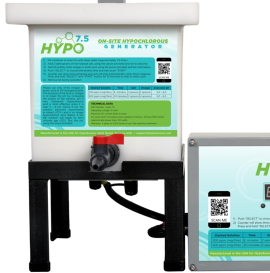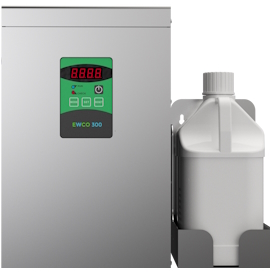Recherche > Terme de recherche: "Listeria"
Noms communs pour les solutions d'acide hypochloreux
- Electrolytically Generated Hypochlorous Acid
- Neutral Electrolyzed Water (NEW)
- Electrolyzed Oxidizing Water (EOW)
- Electro-chemically Activated Water (ECA)
- Super-oxidized water (SOW)
Résultats: 75 articles publiés

Microbe(s): Listeria monocytogenes, Escherichia coli, Vibrio parahaemolyticus

Microbe(s): Escherichia coli O157:H7, Listeria monocytogenes

Microbe(s): Clostridium difficile

Microbe(s): Listeria monocytogenes

Microbe(s): Listeria monocytogenes

Microbe(s): Escherichia coli O104:H4, Listeria monocytogenes, Aeromonas hydrophila, Vibrio parahaemolyticus, Campylobacter jejuni

Microbe(s): Vibrio parahaemolyticus

Microbe(s): Listeria monocytogenes, Salmonella enterica

Microbe(s): Listeria monocytogenes, Escherichia coli O157:H7, and Salmonella sp.

Microbe(s): Escherichia coli O157:H7, Listeria monocytogenes, Staphylococcus aureus, and Salmonella Typhimurium

Microbe(s): Escherichia coli O157:H7 Salmonella Typhimurium, Listeria monocytogenes

Microbe(s): Total Microbial Count, Escherichia coli O157:H7, Listeria monocytogenes, Pseudomonas spp., Fungi, Yeast

Microbe(s): Total Microbial Count, Listeria

Microbe(s): Escherichia coli O104: H4, Listeria monocytogenes, Campylobacter jejuni, Aeromonas hydrophila, Vibrio parahaemolyticus

Microbe(s): Listeria monocytogenes

Microbe(s): Salmonella typhimurium, Listeria monocytogenes, Staphylococcus aureus, Escherichia coli

Microbe(s): Escherichia coli O157:H7, Listeria monocytogenes

Microbe(s): Escherichia coli O157:H7, Listeria monocytogenes

Microbe(s): Escherichia coli O157:H7, Salmonella enterica, Listeria monocytogenes

Microbe(s): Listeria monocytogenes

Microbe(s): Escherichia coli O157:H7, Listeria monocytogenes

Microbe(s): Listeria monocytogenes

Microbe(s): Escherichia coli, Listeria innocua

Microbe(s): Listeria monocytogenes, Salmonella Typhimurium

Microbe(s): Escherichia coli O157:H7, Listeria monocytogenes

Microbe(s): (Listeria monocytogenes, Vibrio parahaemolyticus

Microbe(s): Listeria monocytogenes

Microbe(s): Listeria monocytogenes, Morganella morganii

Microbe(s): Escherichia coli, Listeria innocua

Microbe(s): Listeria monocytogenes

Microbe(s): Salmonella enterica, Escherichia coli O157:H7, Listeria monocytogenes

Microbe(s): Escherichia coli O157:H7, Listeria monocytogenes

Microbe(s): Escherichia coli O157:H7, Listeria monocytogenes, Salmonella Typhimurium, Bacillus cereus

Microbe(s): Escherichia coli, Listeria innocua, Salmonella choleraesuis

Microbe(s): Salmonella Enteritidis, Escherichia coli, Staphylococcus aureus, Listeria monocytogenes, and Bacillus cereus

Microbe(s): Escherichia coli O157:H7, Listeria monocytogenes

Microbe(s): Escherichia coli O157:H7, Listeria monocytogenes, Staphylococcus aureus, Salmonella Typhimurium

Microbe(s): Listeria monocytogenes, Escherichia coli O157 : H7

Microbe(s): Escherichia coli K12, Listeria innocua, Pseudomonas putida

Microbe(s): Escherichia coli O157:H7, Salmonella typhimurium, Listeria monocytogenes

Microbe(s): Escherichia coli, Salmonella typhimurium, Staphylococcus aureus, Listeria monocytogenes, and Enterococcus faecalis

Microbe(s): Salmonella, Listeria monocytogenes, Escherichia coli O157:H7, Erwinia carotovora

Microbe(s): Escherichia coli O157:H7, Salmonella Typhimurium, Listeria monocytogenes

Microbe(s): Escherichia coli O157:H7, Salmonella, and Listeria monocytogenes

Microbe(s): Escherichia coli, Listeria monocytogenes, Pseudomonas aeruginosa, Staphylococcus aureus

Microbe(s): Escherichia coli O157:H7, Listeria monocytogenes

Microbe(s): Escherichia coli O157:H7, Salmonella spp., Listeria monocytogenes

Microbe(s): Listeria monocytogenes

Microbe(s): Listeria monocytogenes

Microbe(s): Listeria monocytogenes

Microbe(s): Escherichia coli O157: H7, Listeria monocytogenes

Microbe(s): Listeria monocytogenes

Microbe(s): Escherichia coli, Listeria monocytogenes, Pseudomonas aeruginosa, Staphylococcus aureus

Microbe(s): Listeria monocytogenes

Microbe(s): Listeria monocytogenes

Microbe(s): Salmonella Enteritidis, Listeria monocytogenes

Microbe(s): Salmonella, Listeria, Campylobacter, Escherichia coli

Microbe(s): Listeria monocytogenes, Escherichia coli O157:H7

Microbe(s): Escherichia coli O157:H7, Listeria monocytogenes

Microbe(s): Escherichia coli O157: H7, Listeria monocytogenes

Microbe(s): Listeria monocytogenes, Salmonella typhimurium, Campylobacter coli

Microbe(s): Escherichia coli O157: H7, Salmonella Enteritidis, Listeria monocytogenes

Microbe(s): Salmonella typhimurium, Staphylococcus aureus, and Listeria monocytogenes, Escherichia coli

Microbe(s): Escherichia coli O157: H7, Salmonella Enteritidis, and Listeria monocytogenes

Microbe(s): Salmonella Typhimurium, Listeria monocytogenes

Microbe(s): Salmonella enteritidis, Listeria monocytogenes

Microbe(s): Escherichia coli O157:H7, Salmonella enterica, Listeria monocytogenes

Microbe(s): Listeria monocytogenes, Flavobacterium spp.

Microbe(s): Escherichia coli O157:H7, Listeria monocytogenes

Microbe(s): Listeria monocytogenes

Microbe(s): Listeria monocytogenes

Microbe(s): Escherichia coli O157:H7, Listeria monocytogenes

Microbe(s): Escherichia coli O157:H7, Listeria monocytogenes, Bacillus cereus

Microbe(s): Escherichia coli O157:H7, Salmonella enteritidis, Listeria monocytogenes

Microbe(s): Escherichia coli O157:H7, Listeria monocytogenes
Best Hypochlorous Acid (HOCL) Generators
 Portable Hypochlorous Acid (HOCL) Machine
Portable Hypochlorous Acid (HOCL) Machine
Make high quality hypochlorous acid in the home or office.
$159.99 + Free Shipping
 HOCL Machine + Electrostatic Sprayer
HOCL Machine + Electrostatic Sprayer
Make hypochlorous acid and spray with an electrostatic cold fogger.
$309.98 + Free Shipping


